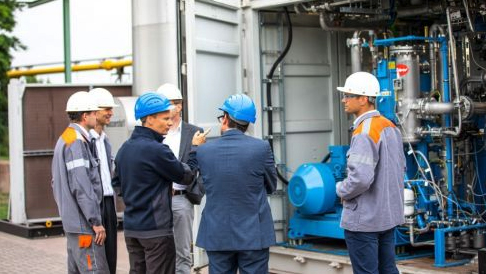- 19. 04. 2022
Sunfire: World’s largest high-temperature electrolyzer achieves record efficiency
Salzgitter, April 19, 2022
In order to reduce CO2 emissions, Salzgitter AG is introducing innovative technologies for climate-friendly steel production. Now, the GrInHy2.0 hydrogen project has achieved another technological breakthrough.
Green hydrogen for climate-friendly steel production – the steel and technology group Salzgitter AG is one of the pioneers when it comes to sustainable production technologies. In order to drastically reduce its own carbon footprint by 2033, the Group is pursuing the SALCOS® – Salzgitter Low CO2 Steelmaking program as a key component of the new Salzgitter AG 2030 strategy.
 The EU-funded hydrogen project GrInHy2.0 is also part of the SALCOS® initiative. The project will test the world’s largest high-temperature electrolyzer for the production of green hydrogen.
The EU-funded hydrogen project GrInHy2.0 is also part of the SALCOS® initiative. The project will test the world’s largest high-temperature electrolyzer for the production of green hydrogen.
“We have been working with our partners on this lighthouse project for many months. In the spring, we have now reached another important milestone,” says project manager Simon Kroop from Salzgitter Mannesmann Forschung. “For the first time, the plant produced 200 Nm3 of green hydrogen per hour. In addition, we can demonstrate the electrical electrolyzer efficiency of 84 %el,LHV. No one before us has achieved this on this scale. By comparison, other electrolysis technologies such as alkali or PEM only achieve efficiencies of around 60 %el,LHV.”
The high-temperature electrolyzer was developed and produced by the Dresden-based electrolysis manufacturer Sunfire. The plant is based on innovative SOEC (Solid Oxide Electrolysis Cell) technology and uses renewable electricity to break down water into its constituent parts, oxygen and hydrogen. The electrolysis process itself is not new – but Sunfire’s SOEC technology is among the most efficient in the world.
“The system runs at operating temperatures of 850 °C and uses steam from waste heat from steel production in Salzgitter,” explains Konstantin Schwarze, Head of Large Systems Product Development at Sunfire. “That’s why our high-temperature electrolyzer requires much less electricity than conventional technologies to produce large quantities of green hydrogen. As part of GrInHy2.0, we were finally able to demonstrate the high efficiency on a megawatt scale.”
“The scarce resource of electricity from renewable sources is ideally used here to generate hydrogen and is a further step towards green steel production. This is proven by the record efficiency. This also supports our strategic Group vision Pioneering for Circular Solutions,” Dr. Stefan Mecke, SALCOS® project spokesman, is certain.
Sunfire CEO Nils Aldag looks proudly at large-scale industrial projects like these: “Our electrolysers enable a green future for industrial groups like Salzgitter AG. We are very pleased to see our technologies successfully in use in industrial environments. Pioneers like Salzgitter are setting a great example. Many more of these are needed so that we can achieve our European climate targets.”
In addition to Salzgitter Flachstahl and Sunfire, Salzgitter Mannesmann Forschung, the SMS Group company Paul Wurth, Tenova and the French research institution CEA are also involved in the GrInHy2.0 project.
More information on GrInHy2.0: www.green-industrial-hydrogen.com.
Image: © Salzgitter AG
This project has received funding from the Fuel Cells and Hydrogen 2 Joint Undertaking (now Clean Hydrogen Partnership) under Grant Agreement No 826350. This Joint Undertaking receives support from the European Union’s Horizon 2020 Research and Innovation program, Hydrogen Europe and Hydrogen Europe Research.
CONTACT
Sunfire GmbH
Gasanstaltstraße 2
01237 Dresden
Germany
Phone: +49 351 896797-0
Fax: +49 351 896797-831
Internet: www.sunfire.de
Email: info@sunfire.de
Share on the network:
